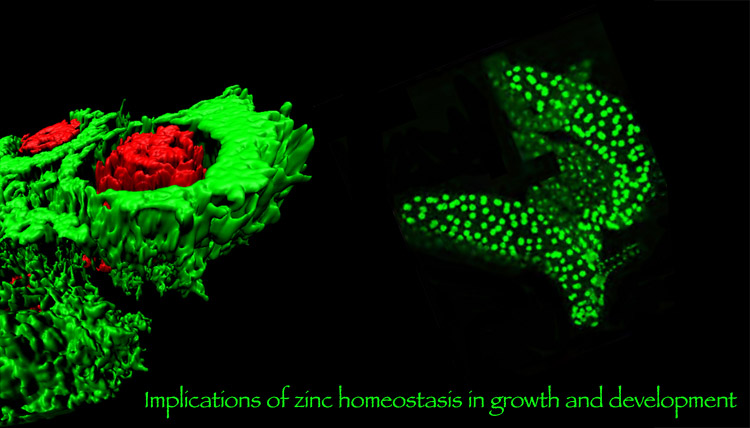Implications of zinc homeostasis in growth and development
Saturday, November 6th, 2010

Left: 3D reconstruction of the mitochondrial network (green) in a salivary gland from a dTRPM mutant cell (nuclei in red). Right: Maximum projection image from a wild type salivary gland expressing key regulators of cell growth. Images: Raghu Padinjat. Design: Geoff Hyde
Childhood diarrhea accounts for a high incidence of mortality in developing countries. Every year, almost 1.5 million children under the age of 5 years die from diarrhea, more than 80% of them in Africa and Asia. A number of studies have found a correlation between the time and dosage of zinc supplementation and alleviation of diarrhea symptoms. The World Health Organization now recommends the use of low-osmolarity oral rehydration solutions, together with zinc supplementation for the treatment of diarrhea. However, the molecular basis for the physiological efficacy of zinc in this setting is ill-defined.
Dr. Padinjat's group, whose primary interest lies in cellular signaling pathways, has been long intrigued by a family of cell membrane ion channels called transient receptor potential membrane (TRPM) channels. These occur in a gamut of organisms, ranging from the nematode, C. elegans, to mammals and by mediating the entry of cations such as Mg2+, Ca2+ and Zn2+, they play important roles in sensory transduction.
More recently, evidence has suggested other roles for TRPM channels in areas unrelated to sensory transduction. Disruption of the trpm7 gene in the much-used zebrafish model system causes defects in growth (e.g. disrupted skeletogenesis and kidney stone formation); these results suggest some role for the channels in ionic homeostasis (equilibrium). However the overall picture must be complex, since Mg2+ and Ca2+ rescue different facets of these aberrations. This is supported by the observation that knocking out the TRPM7 gene in the mouse causes no abnormalities in cellular Mg2+.
Padinjat's approach removed some of the variables that make it difficult to dissect this problem. In particular, unlike the zebrafish or mammals, the fruitfly Drosophila possesses only one type of TRPM channel. Using a combination of genetics, biochemistry and electrophysiology, the researchers found that in flies, this channel acts as a conduit for Zn2+, with minor permeability to Mg2+ and Ca2+, and TRPM function is required to maintain Zn2+ homeostasis.
Experiments done by the group revealed that disruption of the channel caused severe growth defects during larval development leading to lethality in the pre-pupal stages. At the cellular level, this was accompanied by aberrant cell size and mitochondrial morphology. ATP, the energy currency of the cell, was produced at much lower levels, leading to potential misregulation of a variety of cellular processes. With the aid of biochemical assays it was also observed that mutant larvae had altered Zn2+ levels. All of the defects appear to be manifestations of disturbed Zn2+ homeostasis since they can be replicated by depletion of Zn2+ in wild type larvae and ameliorated by extracellular supplementation.
This study not only gives interesting insights into the function of the TRPM channel in flies, but also suggests how Zn2+ homeostasis might be involved in the regulation of growth and development. It also provides a potential clue to the missing link between zinc supplementation and the alleviation of diarrhea. Even under normal circumstances the lining of the intestine must continually replenish its cells, and in diarrhea the cellular turnover will be much higher. The demand for zinc to support this intestinal regrowth might outstrip the supply, and supplementation may restore the balance. Further work in mammalian systems is needed to examine the applicability of these findings to humans.

Comments
Post new comment